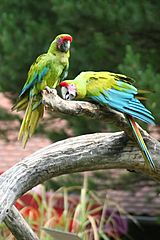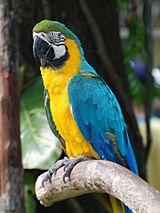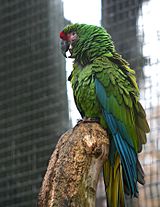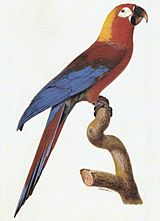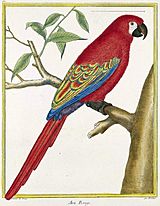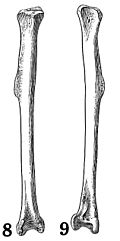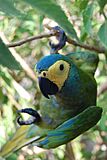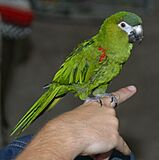List of macaws facts for kids
Macaws are amazing, colorful birds that are part of the parrot family! This list tells you about 19 different types of macaws, including some that are sadly extinct (meaning they no longer exist) or are critically endangered (meaning they are very close to disappearing forever). We won't talk about any macaws that people only *think* might have existed, because there isn't enough proof.
Contents
Meet the Macaws!
Big Blue Macaws (Anodorhynchus)
These macaws are known for their beautiful blue feathers. There are three main types in this group, and each one is unique.
| Species | |||
|---|---|---|---|
| Common and binomial names | Image | Description | Range |
| Glaucous macaw (Anodorhynchus glaucus) |
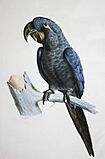 |
70 cm (27.5 in) long, mostly pale turquoise-blue with a large greyish head. It has a long tail and a large bill. It has a yellow, bare eye-ring and half-moon-shaped lappets bordering the mandible. | South America (probably extinct) |
| Hyacinth macaw or hyacinthine macaw (Anodorhynchus hyacinthinus) |
 |
100 cm (39 in) long, 120-140 cm (48-56 in) wingspan. It is almost entirely blue and has black under the wings. It has a large black beak with bright yellow along the sides of the lower part of the beak and also yellow eyerings. | South America |
| Lear's macaw or indigo macaw (Anodorhynchus leari) |
 |
70 cm (27.5 in) long, mainly blue and the head is a slightly paler blue. It has bare pale yellow skin at the base of its beak and orange-yellow eyerings. It has a large blackish beak. | Brazil |
Spix's Macaw (Cyanopsitta)
The Spix's macaw is a very special bird, famous for its pretty blue colors.
| Cyanopsitta | |||
|---|---|---|---|
| Common and binomial names | Image | Description | Range |
| Spix's macaw or little blue macaw (Cyanopsitta spixii) |
This macaw is about 55 to 57 centimeters (21 to 22 inches) long. It has many shades of blue, from a light blue head and belly to bright blue wings and tail. | Brazil (sadly, it's extinct in the wild, meaning it only lives in special breeding programs now) | |
Colorful Macaws (Ara)
The Ara group includes many of the large, vibrant macaws you might think of when you hear the word "macaw." They come in many different colors!
| Ara | |||
|---|---|---|---|
| Common and binomial names | Image | Description | Range |
| Great green macaw or Buffon's macaw (Ara ambiguus) |
85–90 cm (33–36 in) long. Mostly green, red on forehead, green and blue wings | Central and South America, from Honduras to Ecuador | |
| Blue-and-yellow macaw or blue-and-gold macaw (Ara ararauna) |
80–90 cm (31.5–35.5 in) long. Mostly blue back and yellow front. Blue chin and green forehead. The upper zone of the bare white skin around each eye extending to the beak is patterned by lines of small dark feathers. | Panama, Colombia through to south-central Brazil. | |
| Green-winged macaw or red-and-green macaw (Ara chloroptera) |
90 cm (36 in) long. Mostly red, with blue and green wings. The bare white skin around each eye extending to the bill is patterned by lines of small red feathers. | South America, from Colombia through to northern Paraguay (formerly northern Argentina) | |
| Blue-throated macaw (Ara glaucogularis) |
75–85 cm (30–34 in) long. Blue upperparts and mostly yellow lowerparts, blue throat. Areas of pale skin on the sides of the face are covered with lines of small dark-blue feathers, with pinkish bare skin at the base of the beak. | North Bolivia | |
| Scarlet macaw (Ara macao) |
81–96 cm (32–36 in) long. Mostly bright red, with red, yellow and blue in the wings. There is bare white skin around the each eye extending to the bill. | Mexico to Colombia and the Amazon Basin. | |
| Military macaw (Ara militaris) |
70 cm (28 in) long. Mostly green, red forehead | Discontinuous distribution in Mexico and along the Andes from Venezuela to north Argentina. | |
| Red-fronted macaw (Ara rubrogenys) |
55–60 cm (21.5–23.5 in) long. Mostly green. red forehead and red patch over the ears, pinkish skin on the face, red at bend of wings, blue primary wing feathers | Central Bolivia | |
| Chestnut-fronted macaw or severe macaw (Ara severa) |
46 cm (18 in) long. Mostly green, chestnut forehead, red at bend of wings | Panama and South America in the Chocó and Amazon Basin | |
| †Cuban macaw (Ara tricolor) Extinct ca. 1885 |
50 cm (20 in) long. Red forehead fading to orange and then to yellow at the nape of the neck, dark brown bill paler at the tip; orange face, chin, chest, abdomen and thighs; upper back mainly brownish red, and the rump and lower back blue; brown, red and purplish-blue wing feathers; upper surface of the tail was dark red fading to blue at the tip, and brownish red underneath. | Extinct - formerly endemic on Cuba and probably also on Isla de la Juventud (previously called the Isle of Pines). | |
| †Lesser Antillean macaw or Guadeloupe macaw (Ara guadeloupensis) Hypothetical, extinct |
Not known if it existed. Tail feathers 15–20 inches long. Similar colour as the scarlet macaw, but smaller with an entirely red tail. Known from descriptions and possibly paintings and subfossils. | Hypothetical, extinct - Guadeloupe | |
| †St. Croix macaw (Ara autocthones) Extinct |
Only known from sub-fossil bones found at two archeological sites. | Extinct - Saint Croix, U.S. Virgin Islands and central Puerto Rico | |
Red-bellied Macaw (Orthopsittaca)
This macaw is mostly green with a unique red patch on its belly.
| Orthopsittaca | |||
|---|---|---|---|
| Common and binomial names | Image | Description | Range |
| Red-bellied macaw (Orthopsittaca manilata) |
It's about 46 centimeters (18 inches) long. It's mostly green, with a burgundy red spot on its tummy. Its forehead and upper wings are blue, and its chest has a grey tint. The feathers under its wings and tail are a dull yellow. It has bare, mustard-yellow skin on most of its face. | South America | |
Mini Macaws (Primolius)
These macaws are generally smaller than the Ara macaws, but they are still very colorful and active.
| Primolius | |||
|---|---|---|---|
| Common and binomial names | Image | Description | Range |
| Blue-headed macaw or Coulon's macaw (Primolius couloni) |
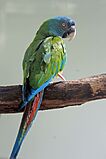 |
41 cm (16 in) long, mostly green with head, flight feathers and primary coverts blue. The uppertail has a maroon base, a narrow green center and a blue tip. The undertail and underwing are greenish-yellow/ The bill is pale greyish-horn with a black base. Unlike most other macaws, the facial skin and lores are dark greyish. | South America |
| Blue-winged macaw or Illiger's macaw (Primolius maracana) |
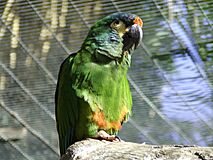 |
40 cm (16 in) long, mostly green, the upperside of some of the wing feathers are blue, and the underside of the wings are yellowish, the tail-tip, crown and cheeks are bluish, and the tail-base and a belly-patch are red. The iris is amber. The bare facial-skin is yellowish, which may be white in captivity, the beak is all black | South America |
| Golden-collared macaw or yellow-collared macaw (Primolius auricollis) |
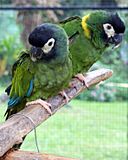 |
38 cm (15 in) long, mostly green, yellow band on the back of the neck, tail feathers have are red at the base fading to greens and blues, dark brown or black forehead, pink legs, the beak is dark grey with a paler grey tip | South America |
Red-shouldered Macaw (Diopsittaca)
Also known as Hahn's macaw, this is the smallest type of macaw.
| Diopsittaca | |||
|---|---|---|---|
| Common and binomial names | Image | Description | Range |
| Red-shouldered macaw or Hahn's macaw (Diopsittaca nobilis) |
This little macaw is about 30 centimeters (12 inches) long. It's mostly green, with dark blue feathers on its forehead and the top of its head. Its wings and tail are bright green on top and olive-green underneath. The front edges of its wings, especially underneath, are red. Its eyes are orange, and the bare skin on its face is white. There are three slightly different kinds of this macaw. | South America | |
See also
- List of parrots
- List of Amazon parrots
- Macaws



